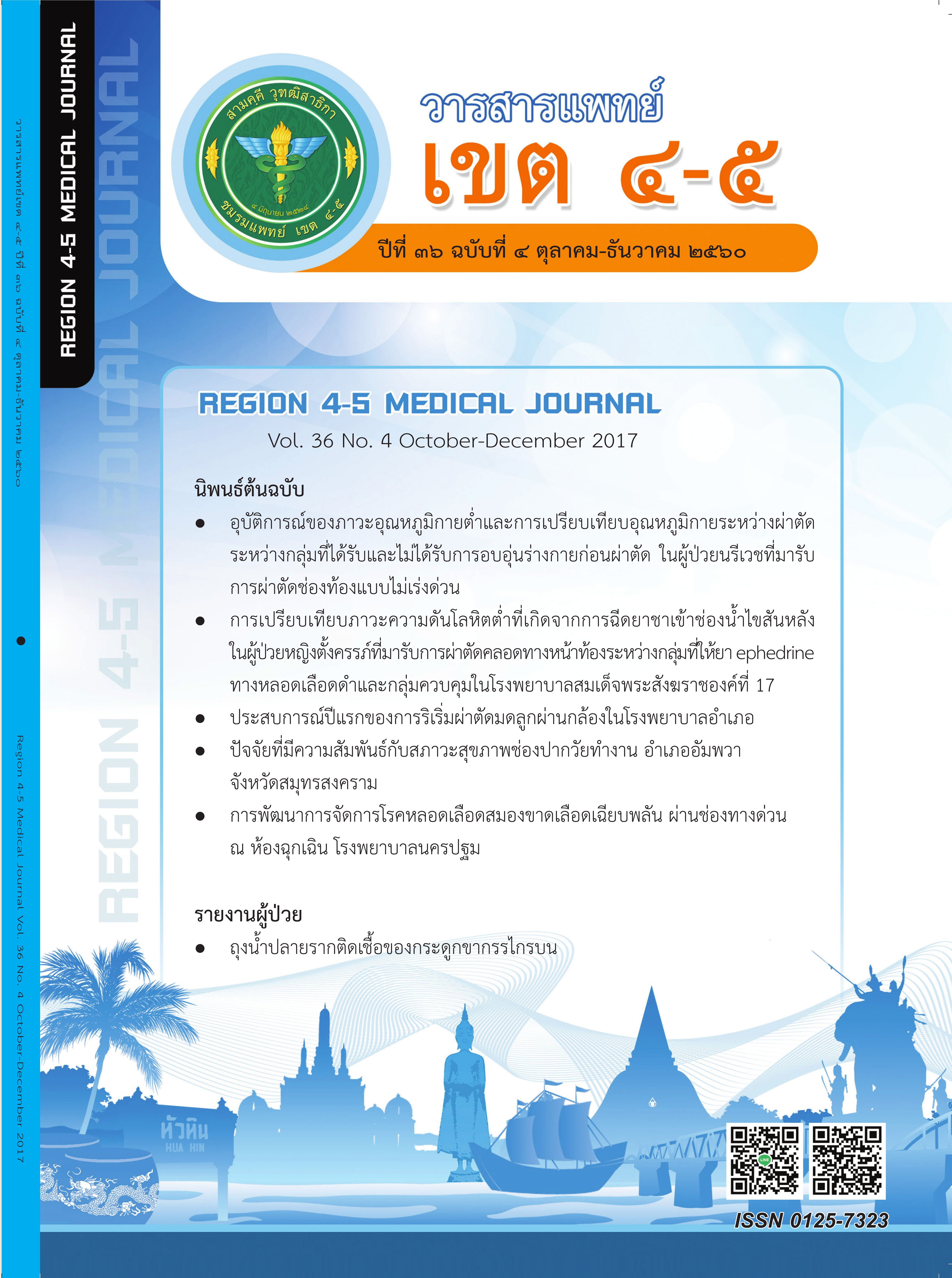อุบัติการณ์ของภาวะอุณหภูมิกายต่ำและการเปรียบเทียบอุณหภูมิกายระหว่างผ่าตัด ระหว่างกลุ่มที่ได้รับและไม่ได้รับการอบอุ่นร่างกายก่อนผ่าตัด ในผู้ป่วยนรีเวชที่มารับ การผ่าตัดช่องท้องแบบไม่เร่งด่วน
คำสำคัญ:
ภาวะอุณหภูมิกายต่ำระหว่างผ่าตัด, การอบอุ่นร่างกายก่อนผ่าตัด, ผ่าตัดนรีเวชแบบไม่เร่งด่วนบทคัดย่อ
วัตถุประสงค์: วัตถุประสงค์หลักคือ เพื่อศึกษาอุบัติการณ์ของภาวะอุณหภูมิกายต่ำในผู้ป่วยนรีเวชที่มารับการผ่าตัดแบบไม่เร่งด่วน วัตถุประสงค์รองคือ เพื่อเปรียบเทียบอุณหภูมิกายระหว่างผ่าตัดในผู้ป่วยนรีเวชที่มารับการผ่าตัดแบบไม่เร่งด่วนระหว่างกลุ่มที่ได้รับการอบอุ่นร่างกายก่อนผ่าตัดและกลุ่มที่ไม่ได้รับการอบอุ่นร่างกายก่อนผ่าตัด
วัสดุและวิธีการ: การศึกษาเชิงวิเคราะห์จากเหตุไปหาผล โดยเก็บข้อมูลย้อนหลังจากเวชระเบียนในผู้ป่วยที่มีอายุมากกว่า 18 ปี ที่ได้รับการผ่าตัดนรีเวชแบบไม่เร่งด่วนและได้รับการระงับความรู้สึกแบบทั่วร่างกายในโรงพยาบาลราชบุรี ตั้งแต่เดือนพฤศจิกายน ถึง ธันวาคม 2559 จำนวน103 คน นำเสนอข้อมูลด้วย จำนวน (ร้อยละ) และค่าเฉลี่ย ± ส่วนเบี่ยงเบนมาตรฐาน เปรียบเทียบความแตกต่างระหว่าง 2 กลุ่ม ด้วย chi-square test และ independent t-test ตามลักษณะของข้อมูล
ผลการศึกษา: อุบัติการณ์รวมของภาวะอุณหภูมิกายต่ำกว่า 36 องศาเซลเซียส คือร้อยละ 5.8 – 17.5 (ร้อยละ 8.7, 13.6, 16.5, 11.7, 5.8 และ17.5 ที่เวลา 30, 60, 90, 120, 150 นาที และเมื่อสิ้นสุดการผ่าตัดตามลำดับ) พบอุบัติการณ์สูงสุดช่วงสิ้นสุดการผ่าตัดคือ ร้อยละ 1.9 และ 34.0 ในกลุ่มที่ได้รับการอบอุ่นร่างกายและไม่ได้รับการอบอุ่นร่างกายก่อนการผ่าตัดตามลำดับ (p<0.001) ในช่วงเวลาอื่นๆ กลุ่มที่ไม่ได้รับการอบอุ่นร่างกายก่อนการผ่าตัดมีอุบัติการณ์อุณหภูมิกายต่ำหลังให้ยาระงับความรู้สึกสูงกว่ากลุ่มที่ได้รับการอบอุ่นร่างกายก่อนการผ่าตัดเช่นเดียวกัน (p< 0.01) และผลการเปรียบเทียบอุณหภูมิกายเฉลี่ยระหว่างผ่าตัดระหว่าง 2 กลุ่มพบว่ากลุ่มที่ได้รับการอบอุ่นร่างกายก่อนผ่าตัดมีอุณหภูมิกายเฉลี่ยสูงกว่ากลุ่มที่ไม่ได้รับการอบอุ่นร่างกายก่อนผ่าตัดคือ 36.50 และ 36.18, 36.52 และ 36.17, 36.50 และ 36.29, 36.60 และ 36.22 องศาเซลเซียสที่เวลา 90, 120, 150 นาทีและเมื่อสิ้นสุดการผ่าตัด ตามลำดับ (p<0.001)
สรุป : การอบอุ่นร่างกายก่อนการผ่าตัดสามารถลดอุบัติการณ์อุณหภูมิกายต่ำหลังให้ยาระงับความรู้สึกในผู้ป่วยนรีเวชที่มารับการผ่าตัดแบบไม่เร่งด่วนได้จึงควรสร้างแนวทางเกี่ยวกับวิธีป้องกันภาวะอุณหภูมิกายต่ำระหว่างผ่าตัด ให้แก่ผู้เกี่ยวข้องได้แก่ วิสัญญีแพทย์, แพทย์ผ่าตัด, วิสัญญีพยาบาลและพยาบาลห้องผ่าตัด เพื่อความร่วมมือที่ดีในการดูแลผู้ป่วยอย่างครบถ้วนต่อไป
เอกสารอ้างอิง
2. Moola S, Lockwood C. Effectiveness of strategies for the management and/or prevention of hypothermia within the adult perioperative environment. Int J Evid Based Healthc 2011;9:337-45.
3. Kurz A, Sessler DI, Lenhardt R. Perioperative normothermia to reduce the incidence of surgical-wound infection and shorten hospitalization. Study of Wound Infection and Temperature Group. N Engl J Med 1996;334:1209-15.
4. Flores-Maldonado A, Medina-Escobedo CE, Rı´os-Rodrı´guez HM, et al. Mild perioperative hypothermia and the risk of wound infection. Arch Med Res 2001;32:227-31.
5. Dimick JB, Chen SL, Taheri PA, et al. Hospital costs associated with surgical complications: a report from the private-sector National Surgical Quality Improvement Program. J Am Coll Surg 2004;199:531-7.
6. Roundtable summary: perioperative temperature management. Anesthesiology News [internet]. 2005 October [cited 2017 January]. Available from: URL: http://www.anesthesiologynews.com.
7. Dhar P. Managing perioperative hypothermia. J Anesth 2000;14:91-7.
8. Frank SM, Fleisher LA, Breslow MJ, et al. Perioperative maintenance of normothermia reduces the incidence of morbid cardiac events. A randomized clinical trial. JAMA 1997;277(14):1127-34.
9. Leslie K, Sessler DI, Bjorksten AR, et al. Mild hypothermia alters propofol pharmacokinetics and increases the duration of action of atracurium. Anesth Analg. 1995;80:1007-14.
10. Bissonnette B, Sessler DI. Mild hypothermia does not impair postanesthetic recovery in infants and children. Anesth Analg 1993;76(1):168-72.
11. Staab DB, Sorensen VJ, Fath JJ, et al. Coagulation defects resulting from ambient temperature-induced hypothermia. J Trauma 1994;36(5):634-8.
12. Schmied H, Kurz A, Sessler DI, et al. Mild hypothermia increases blood loss and transfusion requirements during total hip arthroplasty. Lancet 1996;347:289-92.
13. Bay J, Nunn JF, Prys-Roberts C. Factors influencing arterial PO2 during recovery from anaesthesia. Br J Anaesth 1968;40:398-407.
14. Scott EM, Buckland R. A systematic review of intraoperative warming to prevent postoperative complications. AORN J 2006;83:1090-104, 1107-13.
15. Wagner D, Byrne M, Kolcaba K. Effects of comfort warming on preoperative patients. AORN J 2006;84:427-48.
16. Hooper VD, Chard R, Clifford T, et al. ASPAN’s evidence-based clinical practice guideline for the promotion of perioperative normothermia. J Perianesth Nurs 2009;24:271-87.
17. Daniel WW. Biostatistics : a foundation for analysis in the health sciences. 6th ed. New York: Wiley; 1995.
18. Ngamjarus C, Chongsuvivatwong V, McNeil E. n4Studies: Sample Size Calculation for an Epidemiological Study on a Smart Device. Siriraj Med J 2016;68:160-70.
19. ชาริณี ประจันทร์นวล และคนอื่นๆ. ปัจจัยที่มีผลต่อภาวะอุณหภูมิกายต่ำขณะผ่าตัดในผู้ป่วยผู้ใหญ่ที่ได้รับการป้องกันตามมาตรฐาน: ศึกษาแบบ case control. วิสัญญีสาร 2556;39(3):183-91.
20. Leijtens B, Koëter M, Kremers K, et al. High incidence of postoperative hypothermia in total knee and total hip arthroplasty: a prospective observational study. J Arthroplasty 2013;28:895–8.
21. Yi J, Xiang Z, Deng X, et al. Incidence of Inadvertent Intraoperative Hypothermia and Its Risk Factors in Patients Undergoing General Anesthesia in Beijing: A Prospective Regional Survey. PLoS One 2015;10:e0136136.
22. Long KC, Tanner EJ, Frey M, et al. Intraoperative hypothermia during primary surgical cytoreduction for advanced ovarian cancer: risk factors and associations with postoperative morbidity. Gynecol Oncol 2013;131:525-30.
23. Sessler DI, Schroeder M, Merrifield B, et al. Optimal duration and temperature of prewarming. Anesthesiology 1995;82:674-81.
24. Perl T, Peichl LH, Reyntjens K, et al. Efficacy of a noval prewarming system in the prevention of perioperative hypothermia. A prospective, randomized, multicenter study. Minerva Anestesiol 2014; 80:436-43.
25. Fossum S, Hays J, Henson MM. A comparison study on the effects of prewarming patients in the outpatient surgery setting. J Perianesth Nurs 2001;16:187-94.
26. Wong PF, Kumar S, Bohra A, et al. Randomized clinical trial of perioperative systemic warming in major elective abdominal surgery. Br J Surg 2007;94:421-6.
27. Connelly L, Cramer E, DeMott Q, et al. The Optimal Time and Method for Surgical Prewarming: A Comprehensive Review of the Literature. J Perianesth Nurs 2017;32:199-209.
ดาวน์โหลด
เผยแพร่แล้ว
รูปแบบการอ้างอิง
ฉบับ
ประเภทบทความ
สัญญาอนุญาต
ลิขสิทธิ์บทความเป็นของผู้เขียนบทความ แต่หากผลงานของท่านได้รับการพิจารณาตีพิมพ์ลงวารสารแพทย์เขต 4-5 จะคงไว้ซึ่งสิทธิ์ในการตีพิมพ์ครั้งแรกด้วยเหตุที่บทความจะปรากฎในวารสารที่เข้าถึงได้ จึงอนุญาตให้นำบทความในวารสารไปใช้ประโยชน์ได้ในเชิงวิชาการโดยจำเป็นต้องมีการอ้างอิงถึงชื่อวารสารอย่างถูกต้อง แต่ไม่อนุญาตให้นำไปใช้ในเชิงพาณิชย์




